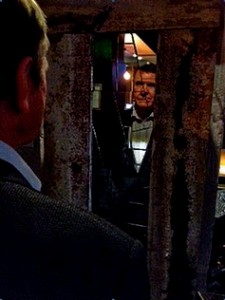A guest post by Brian Miller, first published in The Adelaide Review, October 2011
A faction of rogue wineries, who call themselves ‘Winemakers Without Frontiers’ – but who have plenty of front – recently organised a flash-mob wine tasting at Adelaide Central Market. I stumbled into their ambush and was plied with produce. Louise Hemsley-Smith, from Battle of Bosworth Winery, asked me how I’d heard of the event.
“Did you see us on Facebook? On Twitter?”
“I saw you from across the market,” I replied naively.
“What, with your eyes?” Louise admonished me, “That is so yesterday.”
Oenology is undergoing an e-change. Louise is ahead of the pack and can take you on a virtual tour of her winery via iPad. That’s when she can wrestle the thing away from her offspring.
Wine lovers once relied on intuition to seek each other out; secret signals and cryptic codes that rivalled da Vinci’s. They do employ an insider’s language, but so do pilots, petrol-heads and programmers. Wine can be described in plain language, but plain language restricts creativity, variety and fun. There is range of descriptors more expressive than “awesome” and “crap”. It’s not snobbery. There are few wine snobs in the wine game – few that last – but there is an invisible hierarchy.
At the apex of the wine-word pyramid are the judges. They have to juggle tasting-glasses, reading-glasses, catalogues, clip-boards, egos and biros, while simultaneously sniffing, swirling, sipping, spitting and scribbling. So they have reduced their notes to obscure abbreviations that long preceded SMS texting. To help decipher the defects they detect, “V.A.” stands for Volatile Acidity (vinegar), “Brett” is Brettanomyces (a medicinal smell and metallic taste), “???” means “wait to hear what the other judge says first” and “DNPIM” translates as “Do Not Put In Mouth”.
Their professional patois flows down to fellow travellers, but can date you if you cling to a lingo too long. “Cork taint” is the piquant aroma of damp forgotten towels. Its acrimonious acronym is “TCA” and only Trekkies can pronounce what that abbreviates (Trichloroanisole 246). You don’t even have to say “corked” any more, just sniff the wine, raise an eyebrow and discard your glass. Everyone will know. As corks go the way of the Dodo, to detect TCA in ten years’ time you will have to open a Grange, a Mouton or a teenager’s bedroom.
Perhaps our social wine instincts are being displaced by digital devices. Why sense when you can signal, or talk when you can text? A day rarely passes without an email arriving from a winery requesting friendship on Facebook. Some come from self-confessed Luddites, so it’s the next generation who are generating these social networks. Wineries that prided themselves on tradition are fast adapting marketing modernity. This is front-of-house only. Back at the vineyards and wineries, the word “technology” has fallen from favour. Not the practice, just the word. It was technology that primed Australia’s world wine advance over recent decades, but now the buzz-words from the back-room are “natural”, “organic” and “sustainable”. Ironically, these warm and fuzzy primal reassurances are increasingly disseminated electronically by gadgets that go “beep”.
A phone app (application) called ‘Goggles’ allows you to scan a wine label with your smart-phone’s camera. The screen briefly goes all Mondrian, and then tells you everything you did not know you needed to know about the wine, including its star-sign, DNA profile and compatibility with Moroccan Tagine Lamb. You employ this astounding application four times to amaze your four friends, then store it away in a phone-folder along with the virtual compass, beer glass and bubble-wrap popping apps. Just like the bread, pasta and ice-cream makers languishing at the deepest recesses of your least accessible kitchen cupboard.
Wineries once promoted their products on branded glassware, casual wear and corkscrews (remember corkscrews?). Vinteloper Winery emblazons its name on skateboards. Wine and skateboards. I await the ominous results on Australia’s scariest home videos.
In an effort to escape conventional clichés, a Californian blogger posed this question to Napa Valley winemakers: “If the 2009 vintage were a celebrity, who would it be and why?” There was little consensus. Replies ranged from Juliette Binoche to Halle Berry to Cate Blanchett, and revealed more about the vignerons than the vintage. I suggested that, in Australia, the 2011 vintage was Lady Gaga. A wise winemaker corrected me: “No, more like Amy Winehouse”.
How much does wine language matter? Not as much as the wine’s taste and story, experience and context. One great pleasure of wine is its democracy. Wine-wank was wrestled away from the aristocracy ages ago, and they can’t have it back. Wine is a social lubricant, best imbibed with food and friends, and free of flim-flam.
A nurse I knew expressed extreme dislike of a famous Chardonnay because “it smells like work”. Pardon? “Hospital swabs, antiseptic wipes, like … where I work”. I took another sniff and saw – via her senses – what I had overlooked, taken for granted or subjectively forgiven. Yes, sappy (expensive) new oak and young lifted alcohol can smell a bit (or a lot) antiseptic and clinical. You are never so expert that you can’t learn from a novice whose nose knows.
 Only as a last resort may you revert to rhetoric. For a ‘Cabernet Cabaret’ years ago, I misappropriated Gilbert & Sullivan’s ‘Major General’s Song’ to that precise purpose:
Only as a last resort may you revert to rhetoric. For a ‘Cabernet Cabaret’ years ago, I misappropriated Gilbert & Sullivan’s ‘Major General’s Song’ to that precise purpose:
“When wines are masked, my comments about acid and astringency
Are broad enough to cover every possible contingency”
If you don’t know the tune, you can Google it.
……………………………………………………………………….
Brian Miller is the very model of a modern wine-executive and executes the marketing of vintages consecutive.
Brian supplied a photo, but I can’t be sure it’s really of him.
Kim